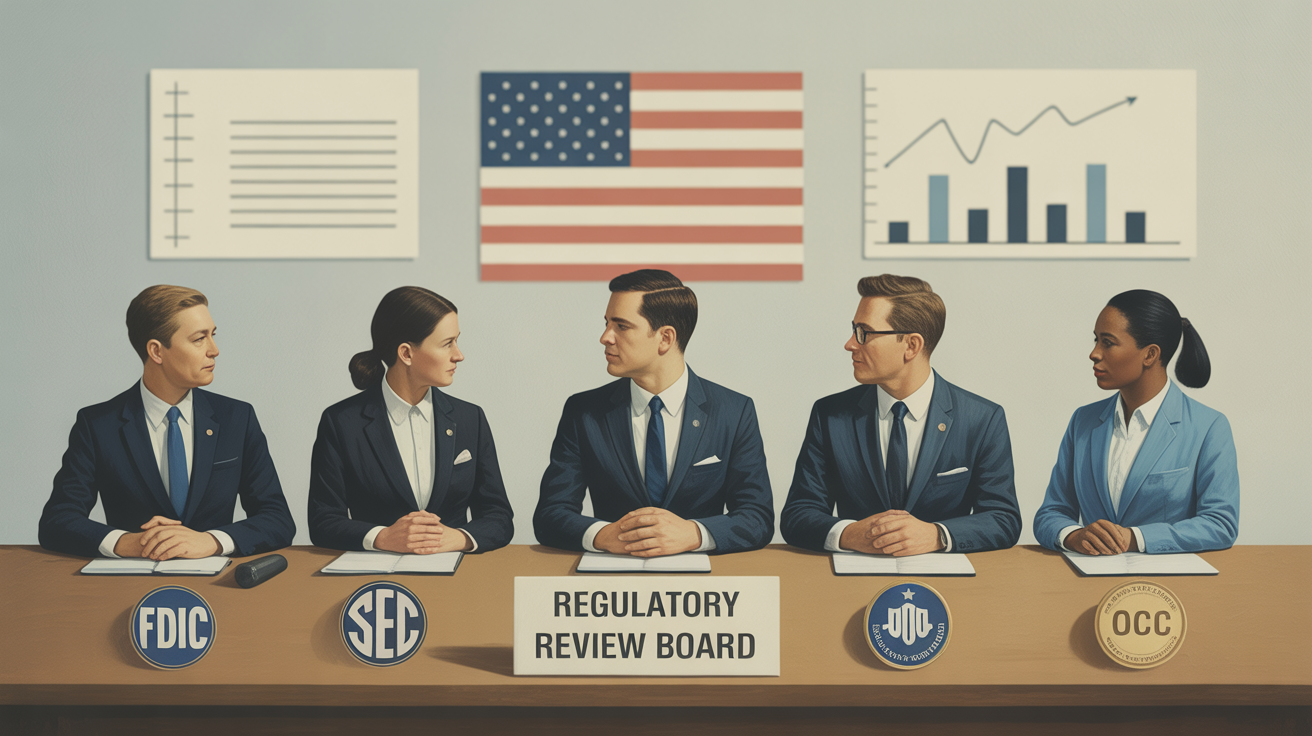Bank marketing compliance has become a big deal in recent years, and for good reason. Regulators are looking much more closely at what banks are doing and handing out some serious penalties. In 2023 alone, the Consumer Financial Protection Bureau (CFPB) filed 29 enforcement actions that made offending companies pay about $3.07 billion in consumer redress and $498 million in civil penalties. At the same time, people are complaining more than ever — by September 2023, over 900,000 complaints had been submitted to the CFPB's database, a 62% increase from the same period a year before.
With all these complaints (which regulators use to find leads) and those headline-making fines, non-compliance can also damage customer trust. Studies show that when consumers feel misled by one bank advertisement, they become skeptical of all ads from that bank after that — which is a kind of long-term brand damage that no financial institution can really afford.
What is Bank Marketing Compliance?
Bank marketing compliance is all about making sure your bank's promotional content — from ads and emails to social media and websites — meets financial industry regulations and truthful bank advertising laws before it goes live. In practice, compliance works as the final checkpoint for marketing materials, checking that claims are accurate, required disclosures are included, and no consumer protection rules are broken.
Key regulators see marketing compliance as essential to consumer protection: it protects consumers from misleading information and protects the institution from legal and reputation problems.
What is Regulatory Compliance?

Regulatory oversight of bank marketing is changing fast. In the past, examiners mainly checked that brochures and ads included the proper fine print, but today regulators have broadened their focus to the entire marketing process. This means they look at how banks target ads, the algorithms used (to spot any unintended bias), the media channels chosen, and campaign performance data to detect patterns of potential discrimination.
In fact, regulators have indicated they may apply fair lending-style reviews to non-loan products, looking closely at marketing of deposit accounts and even business banking for fair outreach. The CFPB has also made clear that third-party digital marketing vendors can fall under consumer finance laws — an interpretive rule in 2022 put digital ad platforms on notice that unfair or discriminatory targeting on behalf of financial clients could violate the Consumer Financial Protection Act's UDAAP provisions.
Another trend is data privacy: a patchwork of new state privacy laws is forcing banks to tighten data use in marketing, with federal privacy legislation on the horizon. Banks must stay aware of these shifting compliance expectations, as the regulatory bar for "clean" marketing is continually being raised.
The Importance of Compliance in Banking
Strong marketing compliance isn't just about avoiding lawsuits — it's about protecting your bank's financial and reputation health. Regulatory penalties for marketing missteps have become huge. In the second half of 2023, U.S. federal and state regulators finalized 22 enforcement actions related to consumer finance marketing, with monetary penalties totaling in the hundreds of millions.
For example, one major bank was hit with $150 million in combined fines by the CFPB and OCC in 2023 for unfair and deceptive marketing practices. The CFPB's enforcement efforts overall secured over $3 billion for consumers in 2023, showing how aggressive regulators have become.
Beyond the direct financial cost, compliance failures carry reputational risk. Trust is fundamental in banking, and it can be quickly damaged. In a Cisco-sponsored consumer survey, 30% of respondents said a company's compliance record was the most important factor in building trust, second only to transparency. So, strong compliance in marketing is not just about avoiding fines — it's about maintaining your bank's reputation, customer loyalty, and ultimately the bottom line.
Key Players: Regulators and Regulatory Bodies

Multiple oversight bodies keep banks' marketing on a short leash in the United States. The Consumer Financial Protection Bureau (CFPB) is a primary enforcer for consumer financial products. The Office of the Comptroller of the Currency (OCC), which supervises national banks, often works together with the CFPB — as seen when the OCC issued a $60 million penalty alongside the CFPB's $90 million fine against a large bank for double-dipping fees.
The Federal Trade Commission (FTC) also steps in on marketing issues, especially for non-bank financial players and unfair or deceptive acts. The Federal Deposit Insurance Corp. (FDIC) polices bank advertising related to deposit insurance and consumer protection for state-chartered banks — it even updated its official Advertising Rule in April 2024 to clarify prohibitions on misusing the FDIC name or logo.
FINRA and its advertising rules oversees marketing compliance for brokerage services offered by banks, while state regulators and attorneys general are very active too: about 67% of the marketing-related enforcement actions in late 2023 came from state agencies. This means banks must navigate not just federal rules but also state-level laws.
How is Marketing Compliance Managed?
Banks approach marketing compliance through structured programs and multi-layered oversight. Typically, a bank's Compliance or Legal department is embedded in the marketing process as a mandatory reviewer, effectively serving as the last line of defense before any campaign is launched.
Many banks have formal pre-approval processes, often documented in detail. For example, it's now considered best practice to "risk-rate" marketing campaigns at inception — if a campaign involves higher-risk elements (like targeting a specific demographic or a novel product claim), it receives extra scrutiny and sign-offs.
In addition, banks conduct cross-functional meetings where marketing, compliance, and often legal discuss upcoming campaigns early on. It's worth noting that much of this is still done manually or with simple workflow tools — compliance officers often manually review every piece of content against checklists, which can be time-consuming.
However, institutions are seeking to modernize: a 2025 industry survey found that marketing compliance is becoming "deeply embedded" in most organizations' culture, with many banks instituting cross-departmental training and collaboration so that compliance is not an afterthought but a built-in aspect of marketing strategy.
Challenges in Marketing Material Compliance
Ensuring every marketing piece is compliant is not easy. A joint survey of 550 marketing and compliance professionals in 2023 revealed that the sheer volume of content is a top challenge — 35% of compliance/legal staff said they're overwhelmed by the amount of marketing content they must review.
Another challenge is the knowledge gap between teams: 30% cited a lack of understanding within their organization about the financial and reputational risks of non-compliant marketing. A further pain point is the emergence of new channels and formats — about 20% expressed concern that newer marketing platforms lack clear regulatory guidelines.
Operationally, manual processes add to the burden. Banks report that having to comb through materials by hand, combined with juggling multiple priorities, is a major obstacle. All these factors can lead to delays in campaign launches, tension between marketing creativity and compliance conservatism, and the risk of errors.
The Role of Compliance Teams
In most financial institutions, compliance teams play a pivotal, hands-on role throughout marketing campaigns. They are integrated into the campaign development lifecycle.
A bank's compliance team is responsible for setting the policies for what is and isn't allowed in marketing content — for example, issuing guidelines on phrasing and vetting targeting criteria to avoid disparate impact.
Resource-wise, banks are dedicating more personnel to this oversight. More than one-third of U.S. banks surveyed in 2024 planned to hire additional compliance staff to handle rising workloads and risk areas.
The compliance team's responsibilities also include training and educating the marketing team. If marketers don't understand the rules, mistakes will happen; tellingly, 82% of compliance pros believe that marketers' limited knowledge of compliance is a root problem.
In short, the compliance team wears many hats: policy setter, educator, reviewer, approver, and guardian ensuring that campaigns can achieve their goals without crossing regulatory lines.
Regulatory Requirements for Marketing Content
Bank marketing content must navigate a web of laws and regulations to stay compliant. At a high level, truth-in-advertising principles apply: all claims in ads must be truthful and not misleading, and any material limitations or conditions must be clearly disclosed.
Under federal law, the CFPB and FTC enforce UDAAP/UDAP — Unfair, Deceptive, or Abusive Acts or Practices. For example, marketing a product as "no fee" when fees in fact apply is considered deceptive.
Fair lending and anti-discrimination laws also extend to marketing. The Equal Credit Opportunity Act (ECOA) and the Fair Housing Act require that marketing for loans or credit products not illegally discriminate.
Specific regulations provide detailed requirements: for instance, the Truth in Lending Act (TILA) and its Regulation Z mandate that if certain "trigger terms" are used in a loan advertisement, the ad must also include additional key disclosures.
In fact, TILA violations are the most common compliance issue cited in bank exams — they accounted for 36% of all FDIC compliance infractions in 2023.
For deposit accounts, Regulation DD (Truth in Savings) requires banks to disclose things like the annual percentage yield (APY), minimum balance, and fees when an ad mentions a deposit interest rate or bonus.
Privacy and data use rules also come into play. Finally, "UDAAP/UDAP" broadly prohibits unfair or deceptive practices in marketing: this covers everything from bogus claims to fine-print trickery.
What are Disclosure Requirements?

Disclosure requirements are a cornerstone of marketing compliance — getting them wrong can result in immediate violations. Banks must make sure that any advertising clearly communicates key terms, conditions, and limitations of the product being promoted.
A classic example is credit card or loan offers: if an ad mentions an interest rate or "0% APR for 12 months," TILA and Reg Z require that the ad also disclose things like the duration of the rate, the APR after the promo period, and any applicable fees.
In fact, TILA/Reg Z violations comprised 36% of violations in 2023, illustrating how frequently banks trip up on disclosure rules.
Proper disclosure isn't just about including the info; it's also about prominence and understandability. Regulators have penalized banks for burying important terms in fine print or using confusing language.
A recent enforcement example: the CFPB permanently banned a mortgage lender for repeated deceptive mailers that misrepresented government affiliation — the company's ads looked like official VA or FHA notices.
Banks need to check these disclosures are conspicuous. A rule of thumb is that anything that could influence a sufficient consumer's knowledge of the offer must be upfront.
How Marketing Compliance Technology Helps?
In recent years, banks have turned to technology solutions to strengthen marketing compliance, and these tools have proven invaluable in easing regulatory scrutiny. Marketing compliance technology refers to software and platforms that automate compliance tasks.
These tools can dramatically improve a bank's ability to withstand regulatory scrutiny in a few ways:
Improved oversight efficiency: Automation means compliance teams can review marketing materials much faster. Instead of manually reading through every word of an ad, a compliance platform can highlight problematic phrases instantly. This not only speeds up approval times but also reduces the chance of human error. Faster, more accurate reviews mean fewer compliance issues slip through.
Centralized documentation: Many compliance platforms provide a single repository for all marketing assets, along with their approval history. If an examiner comes knocking, the compliance officer can quickly pull up records from the system. Having every approval logged shows regulators that the bank has a robust compliance infrastructure.
Real-time monitoring: Advanced compliance tech can continuously monitor live marketing channels. For example, some banks use web-crawling tools to monitor their website and social media in real time, getting alerts if an outdated rate appears or if a required disclosure gets removed. This real-time issue detection means banks can catch and fix compliance issues before regulators even notice.
Scalability: As banks scale up digital marketing, manual compliance processes struggle to keep up with volume. Technology, however, scales nicely — it can review thousands of ads or messages across channels consistently. When regulators see that a bank is leveraging compliance technology, it often gives them comfort that the bank can handle large-scale compliance monitoring.
The ROI of marketing compliance tech can be quite substantial. While it doesn't directly generate revenue, it prevents costly problems. It also preserves the bank's reputation and customer trust. A Cisco study found that 30% of consumers said that a company's strong compliance practices were the most important factor in trusting the brand.
Implementing Real-time Compliance Monitoring

Implementing real-time compliance monitoring involves integrating tools and processes that continuously check marketing outputs as they happen. Many banks are now partnering with specialized RegTech vendors to achieve this.
Real-time monitoring can also extend to third-party channels: if a bank has affiliates or brokers marketing its products, the system can scan those external websites or social feeds to guarantee brand and compliance standards are met.
Industry uptake of real-time monitoring is growing steadily. A regulatory tech survey in 2024 indicated that about 63% of financial institutions plan to increase automation and real-time monitoring in their compliance programs. The move to real-time is driven by the recognition that issues can emerge at any moment (especially on social media, which is 24/7) and waiting for a periodic manual review might be too late.
Big banks and fintech-oriented banks alike are vocal about the importance of ongoing monitoring. JPMorgan Chase, for example, has emphasized that "good compliance is good business," building continuous compliance checks into their business principles. Fintech-heavy banks like Cross River Bank tout a "compliance-first" ethos, noting that having strong compliance and monitoring baked in "helps future-proof operations".
Leveraging AI-Powered Solutions
Artificial Intelligence is playing an increasingly prominent role in bank marketing compliance, though the industry is still in early days of adoption. AI-powered solutions can improve compliance efforts by analyzing vast amounts of data and spotting patterns or anomalies that humans might miss.
For example, AI can be used to automatically review marketing copy — natural language processing algorithms can detect phrases that might be considered misleading or not compliant and suggest corrections. AI can also learn from past compliance reviews to improve its accuracy over time.
However, in practice, bank adoption of AI for marketing compliance is cautious so far. According to an ABA survey published in 2024, only 17% of banks had deployed AI-powered marketing tools. That said, an additional 23% of banks planned to begin using AI in marketing within the next 12 months.
The reluctance to fully embrace AI comes from legitimate concerns. Banks identified major barriers like lack of expertise and data privacy/ethical concerns as reasons for slow AI adoption in marketing: 61% cited a lack of understanding or expertise in AI and 66% pointed to data privacy and ethics worries as inhibiting factors.
The key for banks is to leverage AI as a tool to aid human compliance teams, not replace them — at least until the AI's reliability is proven.
Final Thoughts: Transform Your Marketing Compliance
Bank marketing compliance has moved from a checkbox to a central, strategic concern for financial institutions. The trends of 2023-2025 make one thing clear: the regulatory expectations on banks' marketing practices will only intensify. In fact, signals from regulators point to more — not less — enforcement ahead. The CFPB has explicitly stated it is going "full steam ahead" with aggressive oversight and enforcement actions in 2024 and beyond.
On a positive note, we're seeing a shift in mindset: banks are increasingly viewing compliance as an enabler of trust and long-term success rather than a roadblock.
We understand the compliance burden your marketing team faces. That's why at Luthor, we've built an AI-driven compliance platform specifically designed for regulated businesses like yours. Our solution continuously scans your marketing content—across websites, emails, social media, and more—to catch potential regulatory issues before they become problems.
We don't replace your compliance teams. Instead, we act as a force multiplier, automating repetitive tasks and providing real-time compliance tips so that your professionals can focus on higher-value initiatives. By streamlining and standardizing the review process, Luthor helps you maintain compliance more efficiently and effectively.
As regulatory pressure increases and marketing channels multiply, having the right technology partner becomes not just helpful, but essential. Ready to see how Luthor can transform your marketing compliance workflow? Request a demo today and learn how our platform can help you reduce risk, effort, and time while tackling marketing compliance at scale.




